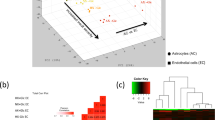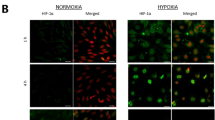Abstract
Among the components of the blood–brain barrier (BBB), endothelial cells (ECs) play an important role in supplying limited materials, especially glucose, to the brain. However, the mechanism by which glucose is metabolized in brain ECs is still elusive. To address this topic, we assessed the metabolic signature of glucose utilization using live-cell metabolic assays and liquid chromatography–tandem mass spectrometry metabolomic analysis. We found that brain ECs are highly dependent on aerobic glycolysis, generating lactate as its final product with minimal consumption of glucose. Glucose treatment decreased the oxygen consumption rate in a dose-dependent manner, indicating the Crabtree effect. Moreover, when glycolysis was inhibited, brain ECs showed impaired permeability to molecules utilizing transcellular pathway. In addition, we found that the blockade of glycolysis in mouse brain with 2-deoxyglucose administration resulted in decreased transcellular permeability of the BBB. In conclusion, utilizing glycolysis in brain ECs has critical roles in the maintenance and permeability of the BBB. Overall, we could conclude that brain ECs are highly glycolytic, and their energy can be used to maintain the transcellular permeability of the BBB.









Similar content being viewed by others
Data availability
Data will be provided by corresponding authors upon proper request.
Code Availability
Not applicable.
References
Iadecola C (2017) The neurovascular unit coming of age: a journey through neurovascular coupling in health and disease. Neuron 96(1):17–42
Keaney J, Campbell M (2015) The dynamic blood–brain barrier. FEBS J 282(21):4067–4079
Abbott NJ et al (2010) Structure and function of the blood–brain barrier. Neurobiol Dis 37(1):13–25
Saunders N, Liddelow S, Dziegielewska K (2012) Barrier mechanisms in the developing brain. Front Pharmacol 3(46)
Shah K, Desilva S, Abbruscato T (2012) The role of glucose transporters in brain disease: diabetes and Alzheimer’s Disease. Int J Mol Sci 13(10):12629–12655
Mergenthaler P et al (2013) Sugar for the brain: the role of glucose in physiological and pathological brain function. Trends Neurosci 36(10):587–597
Duelli R, Kuschinsky W (2001) Brain glucose transporters: relationship to local energy demand. Physiol 16(2):71–76
Harris JJ, Jolivet R, Attwell D (2012) Synaptic energy use and supply. Neuron 75(5):762–777
Simpson IA, Carruthers A, Vannucci SJ (2007) Supply and demand in cerebral energy metabolism: the role of nutrient transporters. J Cereb Blood Flow Metab Off J Int Soc Cereb Blood Flow Metab 27(11):1766–1791
Farrell CL, Pardridge WM (1991) Blood-brain barrier glucose transporter is asymmetrically distributed on brain capillary endothelial lumenal and ablumenal membranes: an electron microscopic immunogold study. Proc Natl Acad Sci 88(13):5779–5783
Adeva-Andany MM et al (2016) Liver glucose metabolism in humans. Biosci Rep 36(6):e00416
Li X-B, Gu J-D, Zhou Q-H (2015) Review of aerobic glycolysis and its key enzymes - new targets for lung cancer therapy. Thoracic cancer 6(1):17–24
Wallace DC, Fan W (2010) Energetics, epigenetics, mitochondrial genetics. Mitochondrion 10(1):12–31
Yetkin-Arik B et al (2019) The role of glycolysis and mitochondrial respiration in the formation and functioning of endothelial tip cells during angiogenesis. Sci Rep 9(1):12608
De Bock K et al (2013) Role of PFKFB3-driven glycolysis in vessel sprouting. Cell 154(3):651–663
Jones W, Bianchi K (2015) Aerobic glycolysis: beyond proliferation. Front Immunol 6:227–227
Vander Heiden MG, Cantley LC, Thompson CB (2009) Understanding the Warburg: effect the metabolic requirements of cell proliferation. Sci (New York.N.Y.) 324(5930):1029–1033
Warburg O, Minami S (1923) Versuche an Überlebendem Carcinom-gewebe. Klin Wochenschr 2(17):776–777
Chang C-H et al (2013) Posttranscriptional control of T cell effector function by aerobic glycolysis. Cell 153(6):1239–1251
Gerriets VA, Rathmell JC (2012) Metabolic pathways in T cell fate and function. Trends Immunol 33(4):168–173
Hanahan D, Robert A (2011) Weinberg, Hallmarks of cancer: the next generation. Cell 144(5):646–674
Parra-Bonilla G et al (2010) Critical role for lactate dehydrogenase A in aerobic glycolysis that sustains pulmonary microvascular endothelial cell proliferation. Am J Phys-Lung Cell Mol Phys 299(4):L513–L522
Polet F, Feron O (2013) Endothelial cell metabolism and tumour angiogenesis: glucose and glutamine as essential fuels and lactate as the driving force. J Intern Med 273(2):156–165
Koziel A et al (2012) The influence of high glucose on the aerobic metabolism of endothelial EA.hy926 cells. Pflugers Archiv Eur J Phys 464(6):657–669
Kim B et al (2017) Glutamine fuels proliferation but not migration of endothelial cells. Embo j 36(16):2321–2333
Sweet IR et al (2009) Endothelial inflammation induced by excess glucose is associated with cytosolic glucose 6-phosphate but not increased mitochondrial respiration. Diabetol 52(5):921–931
Zhong Y et al (2015) Application of mitochondrial pyruvate carrier blocker UK5099 creates metabolic reprogram and greater stem-like properties in LnCap prostate cancer cells in vitro. Oncotarget 6(35):37758–37769
Corbet C et al (2018) Interruption of lactate uptake by inhibiting mitochondrial pyruvate transport unravels direct antitumor and radiosensitizing effects. Nat Commun 9(1):1208
Cao Y et al (2019) PFKFB3-mediated endothelial glycolysis promotes pulmonary hypertension. Proc Natl Acad Sci 116(27):13394–13403
Hwang D-Y, Ismail-Beigi F (2002) Glucose uptake and lactate production in cells exposed to CoCl2 and in cells overexpressing the Glut-1 glucose transporter. Arch Biochem Biophys 399(2):206–211
Leithner K et al (2015) PCK2 activation mediates an adaptive response to glucose depletion in lung cancer. Oncogene 34(8):1044–1050
Cumming BM et al (2018) Mycobacterium tuberculosis induces decelerated bioenergetic metabolism in human macrophages. eLife 7. https://doi.org/10.7554/elife.39169.
Hardie DG, Ross FA, Hawley SA (2012) AMPK: a nutrient and energy sensor that maintains energy homeostasis. Nat Rev Mol Cell Biol 13(4):251–262
Jeon S-M (2016) Regulation and function of AMPK in physiology and diseases. Exp Mol Med 48(7):e245–e245
Toth AE et al (2019) The endo-lysosomal system of bEnd3 and hCMEC/D3 brain endothelial cells. Fluids Barriers CNS 16(1):14
Pulgar VM (2019) Transcytosis to cross the blood brain barrier, new advancements and challenges. Front Neurosci 12(1019)
Ayloo S, Gu C (2019) Transcytosis at the blood–brain barrier. Curr Opin Neurobiol 57:32–38
Villaseñor R et al (2016) Trafficking of endogenous immunoglobulins by endothelial cells at the blood-brain barrier. Sci Rep 6(1):25658
Haqqani AS et al (2017) Endosomal trafficking regulates receptor-mediated transcytosis of antibodies across the blood brain barrier. J Cereb Blood Flow Metab 38(4):727–740
Kim K-J et al (2004) Net absorption of IgG via FcRn-mediated transcytosis across rat alveolar epithelial cell monolayers. Am J Phys-Lung Cell Mol Phys 287(3):L616–L622
Xin H et al (2012) The brain targeting mechanism of Angiopep-conjugated poly(ethylene glycol)-co-poly(ɛ-caprolactone) nanoparticles. Biomaterials 33(5):1673–1681
McNaughton BR et al (2009) Mammalian cell penetration, siRNA transfection, and DNA transfection by supercharged proteins. Proc Natl Acad Sci USA 106(15):6111–6116
Lampe M, Vassilopoulos S, Merrifield C (2016) Clathrin coated pits, plaques and adhesion. J Struct Biol 196(1):48–56
Merrifield CJ, Perrais D, Zenisek D (2005) Coupling between clathrin-coated-pit invagination, cortactin recruitment, and membrane scission observed in live cells. Cell 121(4):593–606
Wessling-Resnick M, Braell WA (1990) The sorting and segregation mechanism of the endocytic pathway is functional in a cell-free system. J Biol Chem 265(2):690–699
Nagai N et al (2019) Energy-dependent endocytosis is responsible for drug transcorneal penetration following the instillation of ophthalmic formulations containing indomethacin nanoparticles. Int J Nanomed 14:1213–1227
Elkin SR, Lakoduk AM, Schmid SL (2016) Endocytic pathways and endosomal trafficking: a primer. Wien Med Wochenschr 166(7–8):196–204
Crabtree HG (1929) Observations on the carbohydrate metabolism of tumours. Biochem J 23(3):536–545
Rosas Lemus M et al (2018) The role of glycolysis-derived hexose phosphates in the induction of the Crabtree effect. J Biol Chem 293(33):12843–12854
Shiratori R et al (2019) Glycolytic suppression dramatically changes the intracellular metabolic profile of multiple cancer cell lines in a mitochondrial metabolism-dependent manner. Sci Rep 9(1):18699
Zheng X et al (2016) Metabolic reprogramming during neuronal differentiation from aerobic glycolysis to neuronal oxidative phosphorylation. ELife 5:e13374
Funding
This research was supported by a grant from the National Research Foundation of Korea (NRF) funded by the Ministry of Science, and ICT (NRF- 2021R1C1C1011427 to D.G. Kim) and KBRI basic research program through Korea Brain Research Institute funded by Ministry of Science and ICT (21-BR-02–17 to D.G. Kim), and Korea Health Technology R&D Project through the Korea Health Industry Development Institute (KHIDI), funded by the Ministry of Health and Welfare (H I14C1135).
Author information
Authors and Affiliations
Contributions
ESK, CHL, KSK, MTJ, JHL, and DGK performed experiments. DGK designed studies and conceptualized experiments. ESK, JHL, and DGK analyzed data and wrote manuscripts. JHL and DGK secured funding for this study.
Corresponding authors
Ethics declarations
Ethics Approval
This study was carried out in strict accordance with the recommendations in the Guide for the Care and Use of Laboratory Animals of the National Institutes of Health. The protocol was approved by the Institutional Animal Care and Use Committee of Korea Brain Research Institute (IACUC-17–00002, IACUC-17–00012).
Consent for Publication
All authors reviewed and agreed for the publication of this manuscript.
Conflict of Interest
The authors declare no competing interests.
Additional information
Publisher's Note
Springer Nature remains neutral with regard to jurisdictional claims in published maps and institutional affiliations.
Supplementary Information
Below is the link to the electronic supplementary material.
Rights and permissions
About this article
Cite this article
Kim, E.S., Kim, KS., Lee, C.H. et al. Brain Endothelial Cells Utilize Glycolysis for the Maintenance of the Transcellular Permeability. Mol Neurobiol 59, 4315–4333 (2022). https://doi.org/10.1007/s12035-022-02778-7
Received:
Accepted:
Published:
Issue Date:
DOI: https://doi.org/10.1007/s12035-022-02778-7




